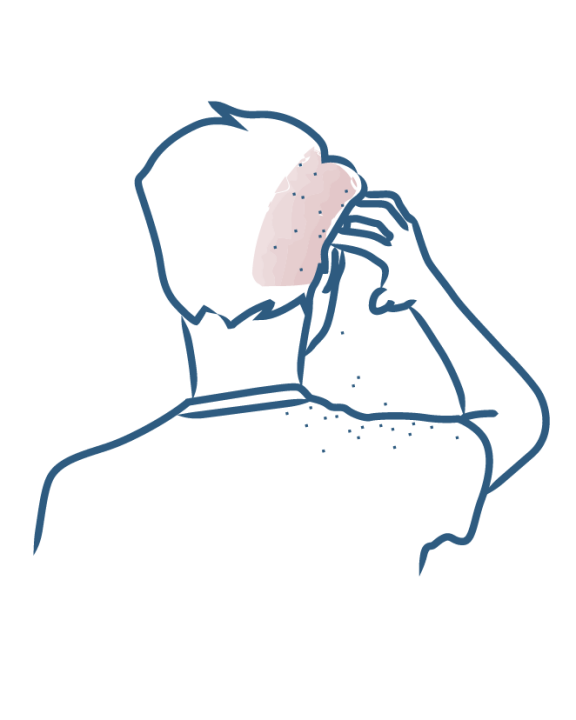
What causes dandruff?
Dandruff is a common scalp condition. It is very easily identified: it is characterised by small white, greyish or yellowish dead cells or scales on the surface of the scalp. It can sometimes be accompanied by itching and irritation. It has numerous causes, and involves several complex mechanisms.
The identified mechanisms
Dandruff is caused quite simply by accelerated cell renewal. Epidermal cells are usually renewed over the space of 21 to 28 days. In the case of dandruff, they are renewed more rapidly, over 5 to 14 days(1). There is no longer enough time for cells to be eliminated progressively at the surface, and instead they accumulate as a mass of scales (clusters of dead epidermal cells), also called dandruff. The acceleration in cell renewal is caused by a scalp disorder, induced by numerous mechanisms.
Defective or excessive sebum secretion by sebaceous glands(3)
When produced in normal quantities, sebum not only plays an essential role in hydrating the skin and scalp, but also protects against external aggressions. When too little is produced, skin becomes dry. When there is too much, it promotes growth of a yeast of the genus Malassezia which contributes to the development of dandruff.
Proliferation of Malassezia yeasts
Yeasts of the genus Malassezia are present naturally on the surface of the scalp. In the specific case of dandruff, they proliferate in excess. They are lipophilic, which means they feed on lipophilic nutrients. The lipids contained in sebum can be an excellent source of food for them. The more they feed, the more they develop, which can result in inflammation and irritation, which can in turn cause desquamation.
Individual scalp sensitivity
There is no explanation as to why some people with an oily or dry scalp will develop dandruff and others will not. This variability and sensitivity is specific to each individual, and reflects a predisposition to developing dandruff that it is unfortunately impossible to change.
As you can see, there are many causes of dandruff. Once we have understood the causes of dandruff and know where the dandruff comes from, we can introduce appropriate, targeted and effective treatment.
Some people are therefore "naturally" prone to dandruff, in other words they are particularly likely to develop it, while others will get dandruff in their hair under the influence of various factors. Overwork, an unbalanced lifestyle, poor use of cosmetic products and even stress can cause a dandruff flare-up.
In order to understand what causes dandruff in more detail, we need to distinguish between dry and oily dandruff. If in doubt, do not hesitate to ask your pharmacist or doctor for guidance.
What causes dry dandruff?
Dry dandruff is small, white, volatile dandruff, which is why it is found not only in the hair but also on clothing, especially on the shoulders.
Dry dandruff develops on a dry scalp. When less sebum is produced, the hydrolipidic film at the surface of the stratum corneum (the outermost layer of the skin) is of a poorer quality and the lipid barrier's protective function is impaired. This damage to the barrier induces loss of water in the scalp, responsible for it becoming dry. This leads to desquamation, and dandruff appears at the surface.
What causes oily dandruff?
Why do I have dandruff on my oily scalp? Simply because the sebaceous glands are producing too much sebum.
This increase in scalp sebum promotes growth of Malassezia yeasts ( Malassezia globosa, Malassezia restricta)(2). These yeasts feed mainly on lipids. They can then cause a reaction, resulting in scalp inflammation, irritation and desquamation.
Oily dandruff itches more than dry dandruff because the scalp is more inflamed.
Once the causes of dandruff are understood, we can establish an appropriate symptomatic treatment to eliminate it. However, there is unfortunately no cure for dandruff yet, so it may reappear. It is therefore worth identifying the external factors that may sustain the process and cause dandruff (e.g. use of unsuitable shampoos, stress, etc.).
(1) https://dermato-info.fr/, French Society of Dermatology.
(2) The Society for Investigative Dermatology, Malassezia globosa and restricta: Breakthrough Understanding of the Etiology and Treatment of Dandruff and Seborrheic Dermatitis through Whole-Genome Analysis, Thomas L. Dawson Jr 1, 2007.
(3) J. Cosmet Dermatol. 2020; 00:1-7. Biophysical characteristics of dandruff-affected scalp categorised on the basis of sebum levels. Ji-Seon Yoon PhD, Jiyong Shim MS, Jun-Man Lim MS, Sun Gyoo Park MS.
Our care routines
Dandruff conditions

